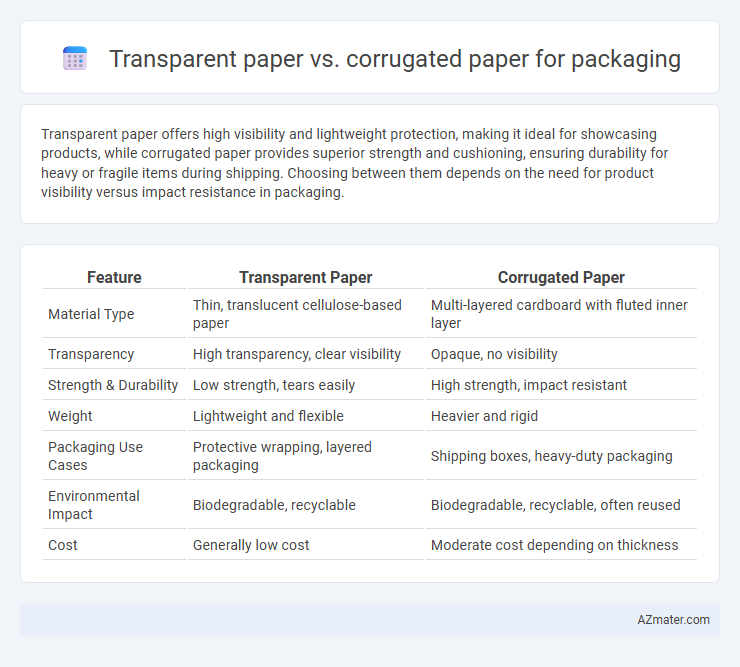Transparent paper offers high visibility and lightweight protection, making it ideal for showcasing products, while corrugated paper provides superior strength and cushioning, ensuring durability for heavy or fragile items during shipping. Choosing between them depends on the need for product visibility versus impact resistance in packaging.
Table of Comparison
| Feature | Transparent Paper | Corrugated Paper |
|---|---|---|
| Material Type | Thin, translucent cellulose-based paper | Multi-layered cardboard with fluted inner layer |
| Transparency | High transparency, clear visibility | Opaque, no visibility |
| Strength & Durability | Low strength, tears easily | High strength, impact resistant |
| Weight | Lightweight and flexible | Heavier and rigid |
| Packaging Use Cases | Protective wrapping, layered packaging | Shipping boxes, heavy-duty packaging |
| Environmental Impact | Biodegradable, recyclable | Biodegradable, recyclable, often reused |
| Cost | Generally low cost | Moderate cost depending on thickness |
Introduction to Transparent and Corrugated Paper in Packaging
Transparent paper offers high visibility and excellent print quality, making it ideal for packaging that showcases a product's appearance while providing moderate protection. Corrugated paper, composed of fluted layers sandwiched between linerboards, excels in durability and cushioning, making it a preferred choice for shipping and heavy-duty packaging. Both materials serve distinct roles in packaging, with transparent paper emphasizing presentation and corrugated paper focusing on strength and protection.
Material Composition: Transparent vs Corrugated Paper
Transparent paper is typically made from cellulose fibers processed to achieve high clarity and minimal opacity, often coated to enhance smoothness and moisture resistance. Corrugated paper consists of multiple layers, including a fluted corrugated sheet sandwiched between linerboards, providing structural strength and cushioning for packaging. The cellulose composition in corrugated paper is thicker and more rigid compared to the thin, smooth, and translucent cellulose fibers in transparent paper.
Visual Appeal and Branding Opportunities
Transparent paper enhances visual appeal by offering product visibility, making it ideal for packaging that highlights intricate designs or vibrant colors, thus strengthening brand recognition through direct consumer engagement. Corrugated paper provides a sturdy, textured surface perfect for printing detailed logos and brand messages, creating a tactile experience that reinforces brand durability and quality. Combining transparent paper's clarity with corrugated paper's robustness allows brands to achieve a balanced packaging solution that maximizes visual impact and brand storytelling.
Strength and Durability Comparison
Corrugated paper offers superior strength and durability compared to transparent paper due to its multi-layered structure consisting of fluted and flat linerboards, which provide enhanced cushioning and resistance to crushing. Transparent paper, often made from coated cellulose fibers, lacks the reinforced layers of corrugated paper, making it more susceptible to tearing and less capable of withstanding heavy loads during packaging and shipping. For applications requiring robust protection and high load-bearing capacity, corrugated paper remains the preferred choice, while transparent paper suits lightweight, aesthetic packaging needs.
Sustainability and Eco-Friendliness
Transparent paper offers high biodegradability and recyclability due to its cellulose-based composition, making it a sustainable choice for eco-friendly packaging. Corrugated paper, made from recycled fibers and fully recyclable, provides excellent durability and protection while maintaining a low environmental impact through reduced resource consumption. Both materials support circular economy principles, but transparent paper excels in compostability, whereas corrugated paper is preferred for strength and reusability in sustainable packaging solutions.
Protective Qualities: Moisture, Shock, and Dust Resistance
Transparent paper offers moderate moisture resistance and is primarily used for lightweight packaging that requires visibility, but it lacks significant shock absorption and dust protection. Corrugated paper excels in protective qualities with superior shock absorption due to its fluted structure, effective moisture resistance when treated or coated, and excellent dust barrier performance, making it ideal for heavy-duty packaging. Choosing corrugated paper significantly enhances product safety in transit by mitigating impacts and environmental factors compared to transparent paper.
Cost Analysis: Transparent Paper vs Corrugated Paper
Transparent paper generally incurs higher material costs compared to corrugated paper due to its specialized production process and limited availability. Corrugated paper offers a cost-effective solution with lower raw material expenses and greater recyclability, making it ideal for bulk packaging needs. Businesses often prefer corrugated paper packaging for budget efficiency, while transparent paper is selected when product visibility justifies the extra expenditure.
Application Suitability for Different Products
Transparent paper excels in packaging applications requiring product visibility, such as food items, cosmetics, and gift wrapping, allowing consumers to inspect the product without opening the package. Corrugated paper is ideal for heavy-duty packaging needs, offering superior cushioning and protection for fragile or bulky products like electronics, appliances, and industrial goods. Selecting between transparent and corrugated paper depends on the balance between visibility and structural strength tailored to the specific product's requirements.
Printing and Customization Capabilities
Transparent paper offers high-quality printing with excellent clarity and vibrant color reproduction, making it ideal for showcasing intricate designs and detailed branding elements. Corrugated paper provides robust surface areas suitable for large-scale printing but may result in less sharp images due to its textured, fluted structure. Customization on transparent paper supports fine graphic details and UV coatings, while corrugated paper customization emphasizes durability with options like flexographic printing and embossing for enhanced tactile appeal.
Market Trends and Future Prospects in Packaging
Transparent paper is gaining traction in sustainable packaging markets due to its biodegradability and ability to showcase product visibility, aligning with eco-conscious consumer preferences. Corrugated paper dominates the packaging industry with robust demand driven by e-commerce growth, offering superior protection and recyclability for shipping applications. Future prospects indicate increased innovation in transparent paper coatings and lightweight corrugated solutions, enabling both materials to expand their market presence amid evolving environmental regulations and global supply chain dynamics.

Infographic: Transparent paper vs Corrugated paper for Packaging
 azmater.com
azmater.com